British occupation of Manila
The British occupation of Manila was an episode in Philippine colonial history when the British Empire occupied the Spanish colonial capital of Manila and the nearby principal port of Cavite for twenty months between 1762 and 1764. The occupation was an extension of the larger Seven Years' War between Britain and France, but which came to involve Spain.
British Manila | |||||||||
|---|---|---|---|---|---|---|---|---|---|
| 1762–1764 | |||||||||
.svg.png) Flag | |||||||||
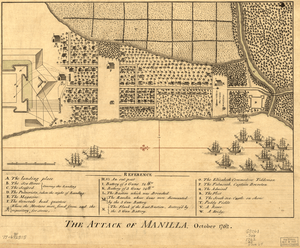 Landing of the British Expeditionary Forces in Manila | |||||||||
| Status | Occupation of Manila by the British Empire | ||||||||
| Capital | Manila, Bacolor, Pampanga (Spanish Philippine colonial government retains control outside of Manila and Cavite) | ||||||||
| Common languages | Spanish and Tagalog | ||||||||
| Religion | Roman Catholicism | ||||||||
| Monarch | |||||||||
• 1760–1820 | George III | ||||||||
| Governor-General | |||||||||
• 1762–1764 | Dawsonne Drake | ||||||||
| Historical era | Spanish colonisation | ||||||||
| 6 October 1762 | |||||||||
| 31 May 1764 | |||||||||
| Currency | Spanish dollar | ||||||||
| |||||||||
The British wanted to use Manila as an entrepôt for trade in the region, particularly with China.[1] In addition, a ransom for the city was delivered to the British on the basis that the city would not continue to be sacked or burnt.[2] The resistance from the provisional Spanish colonial government established by members of the Royal Audience of Manila led by Lieutenant Governor Simón de Anda y Salazar and their Filipino allies prevented British forces from taking control of territory beyond the neighbouring towns of Manila and Cavite.[3]:57
Background
At the time, Britain and France were belligerents in what was later called the Seven Years' War. As the war progressed, the neutral Spanish government became concerned that the string of major French losses at the hands of the British were becoming a threat to Spanish interests. France successfully negotiated a treaty with Spain known as the Family Compact which was signed on 15 August 1761. By an ancillary secret convention, Spain committed to making preparations for war against Britain.[3]:9 Britain first declared war against Spain on 4 January 1762, and on 18 January 1762, Spain issued their own declaration of war against Britain.[4]
On 6 January 1762, the British Cabinet led by Prime Minister John Stuart, agreed to attack Havana in the West Indies, and approved Colonel William Draper's scheme for taking Manila with his forces, which were already in the East Indies.[5] Draper was commanding officer of the 79th Regiment of Foot, which was then stationed at Madras in British India. Weeks later, King George III signed the instructions which permitted Draper to implement his scheme, emphasising that by taking advantage of the 'existing war with Spain', Britain might be able to assure her post-war mercantile expansion. Manila was one of the most important trading cities in Asia during this period, and the British East India Company wanted to extend its influence over the Archipelago.[3]:8 As a result, there was an expectation that the commerce of Spain would suffer a 'crippling blow'.[3]:14
Upon arriving in India, Draper's brevet rank became brigadier general.[3]:12–15 A secret committee of the East India Company agreed to provide a civil governor for the administration of the Islands, and in July 1762, they appointed Dawsonne Drake for the post.[6]
British conquest of Manila
On 24 September 1762,[7] a British fleet of eight ships of the line, three frigates, and four store ships with a force of 6,839 regulars, sailors and marines, sailed into Manila Bay from Madras.[3]:9 The expedition, led by Brigadier-General William Draper and Rear-Admiral Samuel Cornish, captured Manila, "the greatest Spanish fortress in the western Pacific".[3]:1,7,endcover
The Spanish defeat was not really surprising. The former Governor-General of the Philippines, Pedro Manuel de Arandia, had died in 1759 and his replacement, Brigadier Francisco de la Torre had not arrived because of the British attack on Havana in Cuba. The Spanish Crown appointed the Mexican-born Archbishop of Manila Manuel Rojo del Rio y Vieyra as temporary Lieutenant Governor. In part, because the garrison was commanded by the Archbishop instead of a regular military commander, many mistakes were made by the Spanish forces.[3]:33
On 5 October 1762 (4 October local calendar), the night before the fall of the walled city of Manila, the Spanish military persuaded Rojo to summon a council of war. Several times the archbishop wished to capitulate, but was prevented. That same day with very heavy battery fire, the British had successfully breached the walls of the bastion of San Diego. The pioneers had emptied the water in the ditch, dismounted the cannons of that bastion and the two adjoining bastions, San Andes and San Eugeno. In addition they set fire to parts of the town, and drove the Spanish forces from the walls. At dawn of 6 October, British forces attacked the breach and took the fortifications, meeting little resistance.[3]:48–51
During the siege, the Spanish lost three officers, two sergeants, 50 troops of the line, and 30 civilians of the militia, besides many wounded. Among the natives there were 300 killed and 400 wounded. The besiegers suffered 147 killed and wounded,[8][9] of whom sixteen were officers. The fleet fired upon the city more than 5,000 bombs, and more than 20,000 balls.[10]
Occupation
Once Manila fell to British troops, "the soldiers turned to pillage." "Rojo wrote that the sack actually lasted thirty hours or more, although he laid the blame on the domestics of the Spaniards, the Chinese and Filipinos, as much as upon the British soldiers."[3]:52–53 Writing in his journal, Rojo described the events and said: "The city was given over the pillage, which was cruel and lasted for forty hours, without excepting the churches, the archbishopric, and a part of the palace. Although the captain-general (Simon de Anda y Salazar) objected at the end of the twenty-four hours, the pillage really continued, in spite of the orders of the British general (Draper) for it to cease. Rojo himself killed with his own hands a soldier he found transgressing his orders, and had three hanged."[11] The British had demanded a ransom of four million dollars from the Spanish government to which Rojo now agreed to avoid further destruction.[12]
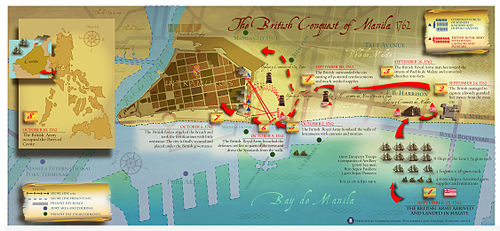
On 2 November 1762, Dawsonne Drake of the British East India Company assumed office as the British Governor of Manila. He was assisted by a council of four, consisting of John L. Smith, Claud Russel, Henry Brooke and Samuel Johnson. When after several attempts, Drake realised that he was not getting as many assets that he expected, he formed a War Council, that he named Chottry Court, with power to imprison anyone. Many Spaniards, Criollos, Mestizos, Chinese, and natives were imprisoned for crimes, that was denounced by Captain Thomas Backhouse, were "only known to himself."[14]
The British expedition was further rewarded after the capture of the treasure ship Filipina, carrying American silver from Acapulco, and in a battle off Cavite the Santísima Trinidad which carried China goods. The cargo of the Trinidad alone was valued at $1.5 million and the ship at $3 million.[3]:75–76
Resistance
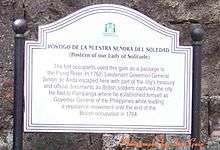
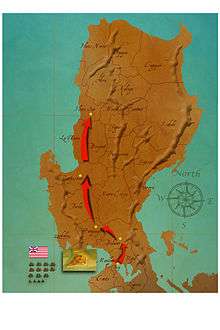
In the meantime, the Royal Audience of Manila had organised a war council and dispatched Oidor Don Simón de Anda y Salazar to the provincial town of Bulacan to organise continued resistance to the British.[3]:48–49 The Real Audencia also appointed Anda as Lieutenant Governor and Visitor-General.[3]:58[15] That night, Anda took a substantial portion of the treasury and official records with him, departing Fort Santiago through the postern of Our Lady of Solitude, to a boat on the Pasig River, and then to Bulacan. He moved headquarters from Bulacan to Bacolor, Pampanga, which was more secure, and quickly obtained the powerful support of the Augustinians.
On 8 October 1762, Anda wrote to Rojo informing him that he had assumed the position of Governor and Capitan-General under the statutes of the Council of the Indies which allowed for the devolution of authority from the Governor to the Audiencia in cases of riot or invasion by foreign forces, as such was the case. Anda, being the highest member of the Audiencia not captive by the British, assumed all powers and demanded the royal seal. Rojo declined to surrender it and refused to recognise Anda as Governor-General.[3]:58–59
The surrender agreement between Archbishop Rojo and the British military guaranteed the Roman Catholic religion and its episcopal government, secured private property, and granted the citizens of the former Spanish colony the rights of peaceful travel and of trade 'as British subjects'. Under British control, the Philippines would continue to be governed by the Real Audiencia, the expenses of which were to be paid by Spain.[3]:54 Anda refused to recognise any of the agreements signed by Rojo as valid, claiming that the Archbishop had been made to sign them by force, and therefore, according to the statutes of the Council of the Indies, they were invalid. He also refused to negotiate with the invaders until he was addressed as the legal Governor-General of the Philippines, returning to the British the letters that were not addressed to that effect. All of these initiatives were later approved by the King of Spain, who rewarded him and other members of the Audiencia, such as José Basco y Vargas, who had fought against the invaders. Anda eventually raised an army which amounted to over 10,000 combatants, most of them volunteer natives, and although they lacked enough modern weapons, they were successful in keeping the British forces confined to Manila and Cavite.
On 26 November, Captain Backhouse dispersed Anda's troops from Pasig and soon after, established a post, manned by Lascars and sepoys so they could dominate Laguna de Bay. Then on 19 January, the following year, the British sent an expedition commanded by Captain Sleigh against Bulacan who was reinforced by 400 Chinese after Anda ordered their massacre. "In Bulacan alone 180 Chinese had been murdered in cold blood or had hanged themselves in fear." The British took Malolos on 22 January, but failed to advance upon Anda in Pampanga and withdrew from there on 7 February. In the spring of 1763, Backhouse undertook another expedition against Anda, advancing as far as Batangas.[3]:64–65,67–68,85–87
Cornish and the East Indies Squadron departed in early 1763, leaving two frigates behind, HMS Falmouth and Seaford. On 24 July, news arrived of the cessation of fighting and on 26 August a preliminary draft of the Peace of Paris. The treaty stated that "All conquests not known about at the time of the signing of the treaty were to be returned to the original owners." The impasse continued in Manila however, as the British order to withdraw would not arrive for another six months, and Anda reinforced his blockade of the city. "During the final winter of the British occupation all pretence of cooperation amongst the British leaders was abandoned."[3]:72,90–92
Final months
The Seven Years' War ended with the signing of the Treaty of Paris on 10 February 1763. At the time of the signing, the signatories were not aware that Manila had been taken by the British, and consequently, it fell under the general provision that all other lands not otherwise provided for be returned to the Spanish Crown.[3]:109 After Archbishop Rojo died in January 1764, the British military finally recognised Simón de Anda y Salazar as the legitimate Governor of the Philippines, sending him a letter addressed to the "Real Audiencia Gobernadora y Capitanía General", after which Anda agreed to an armistice on the condition that the British forces withdraw from Manila by March. However, the British finally received their orders to withdraw in early March, and by mid-March the overdue Spanish governor for the Philippines, Brigadier Don Francisco de la Torre, finally arrived. This Spanish governor brought with him orders from London for Brereton and Backhouse to eventually hand over Manila to himself.[3]:98–100
Drake departed Manila on 29 March 1764, and the Manila Council elected Alexander Dalrymple Provisional Deputy Governor. The British ended the occupation by embarking from Manila and Cavite in the first week of April 1764. The 79th Regiment finally arrived Madras on 25 May 1765.[3]:104–106,108
Aftermath
Diego Silang, who was emboldened by Spanish vulnerability, was promised military assistance if he began a revolt against the Spanish government in the Ilocos Region, but such aid never materialised. Silang was later assassinated by his own friends, and the revolt was aborted after his wife, who had taken over the leadership, was captured and executed together with the remaining rebel forces.[16]
Sultan Alimuddin I of Sulu, who had signed a treaty of alliance with the British forces after they had freed him from Fort Santiago in Manila, where he had been imprisoned accused of treason, was also taken with the evacuating forces, in the hope that he could be of help to the aspirations of the East India Company in the Sultanate of Sulu.[17]
A number of sepoys deserted the British forces and settled down in Pasig, Taytay and Cainta, Rizal.[18]
De la Torre claimed the British destroyed the archives, plundered the palace, removed all naval stores at Cavite and dismantled the city of Manila.[3]:118
The conflict over payment by Spain of the outstanding part of the ransom promised by Rojo in the terms of surrender, and compensation by Britain for the excesses committed by Governor Drake against residents of Manila, continued in Europe for years afterwards.[3]:110–115 The capture of the Spanish treasure galleons Santissima Trinidad and the Filipina however, made the expedition and the occupation rewarding more to the British rather than the East India Company as well as representing a severe loss to Spain.[19][20]
Assessment
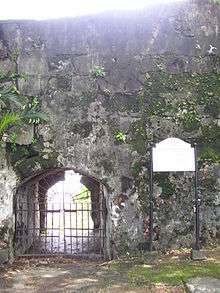
The British failure to extend control beyond Manila and Cavite made their occupation's continuation unviable. Captain Thomas Backhouse reported to the Secretary of War in London that "the enemy is in full possession of the country".[14]:v. 20
The British had accepted the written surrender of the Philippines from Archbishop Rojo on 30 October 1762,[3]:54 but the Royal Audience of Manila had already appointed Simón de Anda y Salazar as the new Governor-General as provided for under the statutes of the Council of the Indies, as was pointed out by Anda and retrospectively confirmed by the King of Spain, in his re-appointment of both Anda and Basco. It was not the first time that the Audiencia had assumed responsibility for the defence of the Philippines in the absence of a higher authority; in 1646, during the Battles of La Naval de Manila, it temporarily assumed the government and maintained the defence of the Philippines against the Dutch.
As Francisco Leandro Viana, who was in Manila during the 20-month occupation, explained to King Charles III in 1765, "the English conquest of the Philippines was just an imagined one, as the English never owned any land beyond the range of the cannons in Manila".[21]
Citations, references, and additional sources
Citations
- Danley & Speelman pp 463-64
- Draper 2006, p. 101.
- Tracy, Nicholas (1995). Manila Ransomed. University of Exeter Press. ISBN 0859894266.
- Fish 2003, p. 2
- Fish 2003, p. 3
- Cornish, Samuel (1761). Cornish to Council at Fort St. George. Public Record Office (PRO), Admiralty Papers.
- British naval calendar date
- Leebrick, Karl Clayton (2007). The English expedition to Manila and the Philippine Islands in the year 1762. University of California, Berkeley. p. 52.
- Blair, Emma Helen (2008). The Philippine Islands, 1493-1803. BiblioBazaar. p. 18. ISBN 978-0-559-25329-4.
- B. Rodríguez, Eulogio (2003). The contribution of the Basque men to the Philippines. Donostia-San Sebastián: Jean-Claude Larronde ed. lit. pp. 535–538. ISBN 84-8419-931-2.
- Renato Perdon article in the Bayanihan News http://bayanihannews.com.au/2014/03/12/british-pillaged-looted-manila-for-40-hours/
- When Britain Ruled the Philippines. Bloomington, IN: AuthorHouse. 2003. ISBN 1-4107-1069-6.
- Presidential Communications Development and Strategic Planning Office. "The British Conquest of Manila". Presidential Museum and Library. Republic of the Philippines. Archived from the original on 20 October 2014. Retrieved 20 October 2014.
- Backhouse, Thomas (1765). The Secretary at War to Mr. Secretary Conway. London: British Library. pp. v. 40.
- Fish 2003, p. 126
- Zaide, Gregorio F, Philippine History and Government, National Bookstore, Manila, 1984
- Fish 2003, pp. 132–133.
- Fish 2003, p. 158
- Routledge, David (1979). Diego Silang and the Origins of Philippine Nationalism - Issue 5 of Monograph series. Philippine Center for Advanced Studies, University of the Philippines. pp. 17–18.
- Draper 2006, p. 116.
- Viana, Francisco Leandro (1765). Manifiesto del Fiscal Viana. Sevilla: Archivo General de Indias. pp. V. 718.
References
- Danley, Mark; Speelman, Patrick (2012). The Seven Years' War: Global Views History of Warfare. Brill. ISBN 9789004236448.
- Fish, Shirley (2003), When Britain ruled the Philippines, 1762-1764: the story of the 18th century British invasion of the Philippines during the Seven Years War, 1stBooks Library, ISBN 978-1-4107-1069-7
- Draper, James (2006). Pitt's 'Gallant Conqueror': The Turbulent Life of Lieutenant General William Draper. I.B.Tauris. ISBN 9781845111779.CS1 maint: ref=harv (link)
Additional sources
- Borschberg, P. (2004), Chinese Merchants, Catholic Clerics and Spanish Colonists in British-Occupied Manila, 1762-1764 in "Maritime China in Transition, 1750-1850", ed. by Wang Gungwu and Ng Chin Keong, Wiesbaden: Harrassowitz, pp. 355–372.
- Tracy, Nicholas (1995) Manila Ransomed: The British Assault on Manila in the Seven Years War. (University of Exeter Press). ISBN 9780859894265
Further reading
- Emma Helen Blair, ed. (1907). The Philippine Islands, 1493-1898 Volume XLIX, 1762-1765. Translated by James Alexander Robertson. The Arthur H. Clark Company. (other formats available)
- Emma Helen Blair, ed. (1907). The Philippine Islands, 1493-1898 Volume L, 1762-1765. Translated by James Alexander Robertson. The Arthur H. Clark Company. (other formats available)
External links
- British Occupation of Manila article on the website of the Presidential Museum and Library. Republic of the Philippines.
